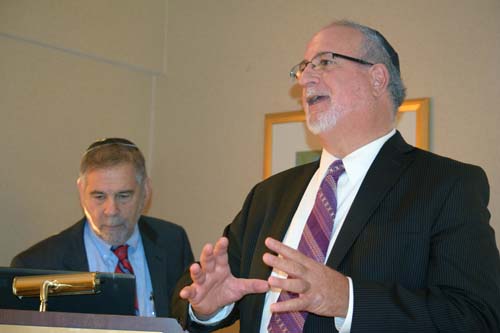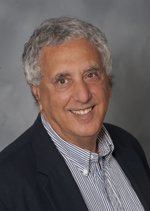
By Donald H. Harrison

LA JOLLA, California – How do you teach about the Holocaust to young people, whom, on the one hand we’d like to protect from learning how brutal the world can be, and whom, on the other hand, we know have to be prepared to live in a world where once again Jewish kids may be exposed, even victimized, by unthinking, unremitting anti- Semitism?
This is a question that has been occupying educators at Jewish day schools, the Center for Initiatives in Jewish Education, and the USC Shoah Foundation. On Wednesday afternoon, Feb. 25, at the Torrey Pines Hilton here, and again on Thursday morning, Feb. 26, in Los Angeles, Michael Berenbaum, the architect of a program still being tweaked, but ready for some classroom testing, previewed a 21st century, computer-driven, interactive approach intended to engage students with value-based questions and allow them to formulate their own answers utilizing videos, graphics, and text.
During a briefing that was attended by Jewish studies faculty and staff from the San Diego Jewish Academy and from Soille San Diego Hebrew Day School, Berenbaum demonstrated the approach by first showing a video of Rabbi Menachem Rubin asking his Talmud students when is the proper time to say the shm’a. (“Hear O Israel, the Lord our God, the Lord is one.”)
The computer lesson then segued to two brief testimonies culled from 1,467 interviews of Holocaust survivors put on line by the USC Shoah Foundation. These are just a fraction of the 32,000 testimonies that were collected by the USC Shoah Foundation, which was largely financed by a grant from movie maker Steven Spielberg, producer of Schindler’s List, among many other movies.
In one of these brief testimonies, Ludmila Page, one of the survivors whose life was saved as a result of being on industrialist Oskar Schindler’s list of workers needed for his factory, recalled being put with others onto a train, and watching two young girls say the shm’a. She thought to herself how wonderful a thing it was that through it all, these girls had faith.
In the second testimony, survivor Frieda Steiglitz remembered being certain that the Nazis who held her captive were going to kill her. She told of looking up to the sky and saying to God, are you going to let me die at age 9 ½? Suddenly, she said, she had a thought that burst upon her consciousness like a telegram from heaven. It said “run.” She did.
One can imagine that a classroom discussion might ensue comparing and contrasting these two experiences, and what the two testimonies say about the statement of faith that is central to the shm’a. But one also could imagine students, being left to do their own research on the computer, choosing various threads to follow. They might want to know more about the lives of Page and Steiglitz, or perhaps learn about the towns from where they came, or perhaps desire to seek out other testimonies about the shm’a.
Berenbaum, a professor of Jewish studies at American Jewish University, is a Holocaust scholar who was project director for the construction of the Holocaust Museum in Washington D.C., and later executive director for the USC Shoah project. He said approximately 2,000 key words have been identified so far to encourage students not only to learn the material, but help to marshal it according to their own interests.
Another example, on a religious theme, was how did concentration camp inmates observe the High Holidays. Rabbi Jacob Jungreis tells in another demonstration video how at his camp there was but one machzor (High Holy Day prayer book) for 850 people, but nearly everyone had learned the prayer directed to “God who examines the innermost recesses of the heart.” So when the Satmar Rebbe, who conducted the service, came to that prayer in the machzor, everyone listening joined in. And when they finished in unison, someone blew a mighty blast on a shofar which had been found in a concentration camp where Nazis held Polish prisoners, and traded for 200 cigarettes. When the shofar was blown, Jungreis recalled, the walls of the barracks shook.
That story segued to another tale told by survivor Ruth Brand. She decided that she would fast for Yom Kippur, though if she were found out, she would be harshly punished. A fellow prisoner told her that if God wanted them to fast, He’d have provided them with better conditions to survive the fast. But Brand counter-suggested that “dafka,” (in spite of everything), perhaps He wanted them to fast.”
In such a manner, said Berenbaum, students can learn the concepts of spiritual resistance and spiritual integrity. And if they feel hungry and cranky at 4 p.m., perhaps, thinking about Brand’s experiences, they might learn some humility.
Other stories from the Holocaust on religious themes including one from survivor George Topas who used to pray in the camps with his tefillin (phylacteries). One day a Nazi guard came upon him doing so, and ripped the tefillin from him and trampled them on the floor. From that day to liberation, recalled Topas, he had to pray without tefillin. He said, with a trace of humor, that perhaps God will forgive him.
Magda Bloom told of a group of men holding a ceremony in which they brought God to judgment. They talked about their complaints, and what they considered His transgressions. But before the “trial” could play out, night fell and it was time for them to pray.
Berenbaum said the aforementioned six examples constituted six minutes of 190,000 hours of testimonies from survivors.
Religious topics are not the only “key words” that one might find in the clips. Another theme might be if someone knows he or she is going to be murdered, should he/she still follow societal rules about waiting until they are ready to declare their love for one another, or even to have sex?
Another thread might be the humor with which Holocaust victims tried to sustain themselves in the camps.
An example was a youngster who was asked if he were Hitler’s child, who could have any wish, what would he ask for”
His answer: “To be an orphan.”
*
Editor’s Note: In the article above, we have now emphasized the phrase “a concentration camp where Nazis held Polish prisoners,” in substitution for our previous sloppily-worded phrase “Polish concentration camp.” Letter writers, whose comments you will read below, correctly point out that the Poles did not maintain the concentration camps, but were in fact prisoners there. We are despondent that anyone thought that was what we intended to say, and, accordingly, we take this opportunity to apologize.
*
Harrison is editor of San Diego Jewish World. Your signed comment may be posted in the space provided below or sent to donald.harrison@sdjewishworld.com
The term ‘Polish concentration camp’ is incorrect. The German Nazis established the ‘concentration camps’ on occupied Polish soil. The camps were not Polish as implied by the comment. Please correct the error.
” found in a Polish concentration camp” – yet again that odious reference to camps built by the Germans in occupied Poland as being in some way Polish, despite the fact that so many non-Jewish Poles, in addition to Jewish Poles, were imprisoned and killed in the camps. Barack Obama apologised abjectly for using this phrase so why do you?
None of the people commenting here pointed out that term “Polish Concentration Camp” was created in the 60’s by Nazis that were allowed to remain in German secret service by Allies after the war. In addition it must be added that 3 million catholic Poles we killed in the Holocaust including my family members in Auschwitz. Furthermore the anti Polish policies were in Place since 1800’s culminating in Holocaust. To this day germany has not confronted it’s antipolonism. On daily basis Poles experience racism in Germany – being beaten up, offended, accused of being thieves and incarcerated. One such instance was the incarceration of a president of the largest Polish construction company when he was on a business trip there.
Operations to whitewash German responsibility for WWII
After the fall of Nazism, the wartime alliances ended and the Cold War began. Numerous war criminals, protected by chancellor Konrad Adenauer,[11][12] joined domestic counter-intelligence in order to spy on the Soviet agents within the American-occupied zone. The United States Army turned to Reinhard Gehlen previously in the Wehrmacht for assistance.[13] The West German intelligence formed Agency 114 (German: Dienststelle 114) within the Gehlen Organization; headed by Alfred Benzinger (a Nazi Abwehrpolizei), who in 1956 launched a coordinated action to move the blame away from the war criminals under various investigations. Benzinger adopted the loaded phrase “Polish death camps” in the mid 1960s in order to suggest, contrarily to the facts, that Poles, not Germans, were responsible for the mass genocide during World War II.[14]
At the height of the Cold War, the clandestine Agency 114 had been merged into the BND, the successor of the Gehlen Org. It was located in Karlsruhe and the Zimmerle & Co. which served as the front, ostensibly specializing in roller blinds. Aside from Soviet counter-intelligence activities, the agency also began monitoring domestic leftists and pacifists. Alfred Benzinger, a well-experienced former officer of the secret Nazi military police Geheime Feldpolizei remained in charge. Among the former Nazis who also worked in the agency were: Konrad Fiebig, and Walter Kurreck.[13] It was Benzinger who coordinated the action to propagate a deceitful term “Polish Concentration Camps” in popular media.[14] Notably, the tenets of those operations still live in the hearts of some politicians including John Mann, the recipient of the Jan Karski Award [15]) who in his interview for the Jewish Chronicle.com proclaimed that the Holocaust was perpetrated by Poland, and that claiming victimhood by Poland is a “revisionist angle” similar to that of Lithuania and Latvia.[16]